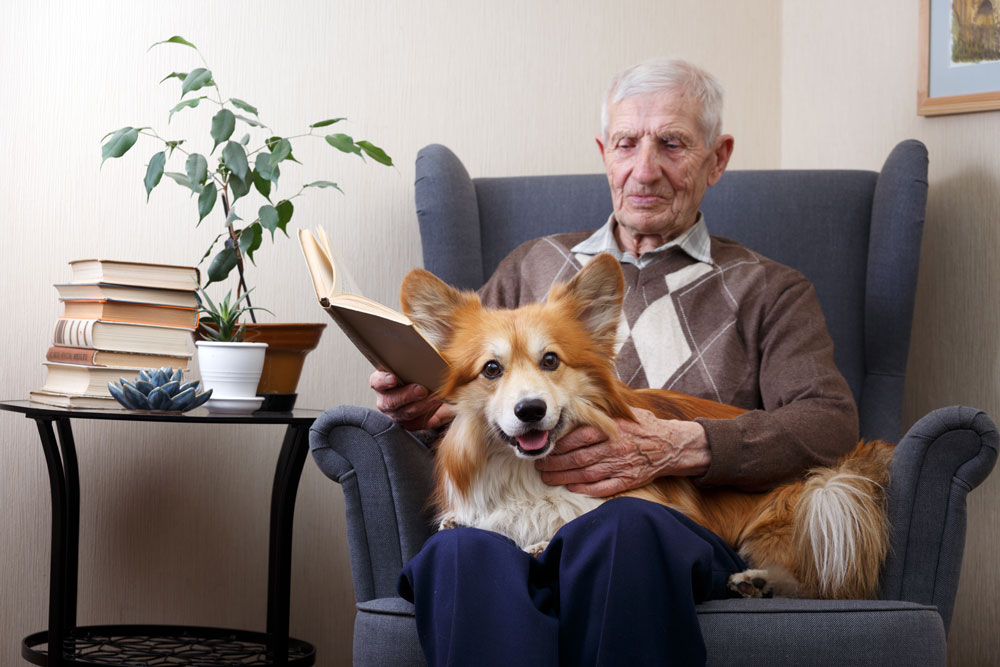Having pets in the nursing home
This article is written based on Swedish conditions but can perhaps be an inspiration for those interested in other countries.
A therapy dog or cat can create both comfort and activity. Therapy dogs are an invaluable asset in health care. Their presence has a proven positive effect on patients' physical and emotional well-being. They offer comfort, support, and joy to people in various care environments, spreading warmth and hope in the hearts of those they meet. Therapy dogs are true heroes with fur, and their contribution to healthcare should be recognized and appreciated.
 Foto: Mostphotos
Foto: MostphotosThe attitude towards having animals in elderly care varies from it being a given to have some cats, to animal visits being avoided due to hygiene and allergies. It happens that relatives bring a dog in connection with the visit. In this case, the relative has full responsibility for the dog. One should be vigilant to ensure that it does not approach someone who is afraid of dogs or ingests something harmful.
There are nursing homes that have a relatively strict attitude to animals, while others have chickens, cats and other animals on or near the premises. The National Board of Health and Welfare has developed guidance for when dogs can be used in care. It applies to what is usually called a care dog.
Animals in care create conditions for physical activity and conversation. A care dog is selected as suitable and specially trained to meet patients. There is a special standard for the certification of care dogs. It is about both the dog handler and the dog being focused on the person they are visiting so that they get all the attention. The National Board of Health and Welfare believes that it is inappropriate for dogs to be uncontrolled in health and social care. Dog and dog handler should work together.
Animals, like children, can create activity and engagement among those who live. The opportunity to pet, walk or talk to an animal can often lead to an increased level of activity. There is always a reason to exchange a few words when there is a dog in the company.
Care Dog
There are studies that show that a care dog improves the mental well-being of many residents. This also applies to people with dementia. If the business works with a care dog, there should be special routines for how the work with the care dog should be conducted. The dog must be able to have a good time when it is not working. It should not be tied or kept in a cage.
Care dogs can alleviate anxiety and have the ability to create joy and laughter. They can be used in rehabilitation to get the elderly to move by going for a walk or just using their hands to pet the dog.
Sometimes a resident brings a dog with them when they move in. It can create concern for the work of taking care of the dog. At the same time, there are nursing homes that can handle it.
The Care Dog a Trustworthy Companion in Care
Care dogs, or therapy dogs, are four-legged friends who have a special place in care environments around the world. These specially trained dogs have the ability to offer comfort, support and joy to patients, regardless of age or health condition. In this article, we will explore the world of care dogs and how they enrich the lives of people in care.
What is a care dog?
A care dog is a dog that has undergone special training to be able to work in care and therapy contexts. These dogs are often known for their gentle nature, patience and ability to create a positive and calming atmosphere. Care dogs can be of different breeds and sizes, and it is their personality and training that mainly defines their role.
How do care dogs work in care environments?
Care dogs can be used in many different ways in care:
Therapy and comfort Care dogs are skilled at providing emotional support and comfort. They can sit by the bedside of patients who feel lonely or worried, and their presence can reduce anxiety and stress.
Physical activity Interacting with a care dog encourages movement and physical activity. This is particularly important for patients who are confined to their beds or wheelchairs.
Social interaction Care dogs can be ice breakers in social situations. They encourage conversation and interaction between caregivers, patients and visitors.
Motivation For patients who are rehabilitating from injuries or illnesses, care dogs can serve as motivating "training partners." Working with a dog can be fun and challenging in a positive way.
Who can benefit from care dogs?
Care dogs have proven to be particularly useful in the following contexts:
Elderly care Care dogs can bring joy and encouragement to nursing homes and older people living at home with home care.
Pediatrics Children's hospitals and clinics have integrated care dogs to make hospital stays more positive for children.
Mental health In psychiatric care, care dogs can offer support to patients with various mental health conditions.
Rehabilitation Care dogs can be used in rehabilitation centers to help patients regain physical and emotional strength.
Training of Care Dogs
Training a care dog is a careful process. Dogs must learn to be calm, friendly and have excellent obedience. The training often includes working in different care environments and being around people with different needs.
Cat
When it comes to cats that are in homes, it is a gray zone. Animal protection rules must of course be followed. This means that there should be routines so that the cat has access to water and food. Likewise, it should be insured, vaccinated, id-marked and possibly neutered. If animals are to be in care, their health and well-being must be followed up in accordance with the Animal Welfare Act. Someone must be responsible for monitoring the cat's well-being. A cat should be supervised at least twice a day so there must be clearly stated who is responsible for the cats even on weekends.
Lex Maja
Lex Maja was created so that animals do not come to harm when their owner or mom ends up in the hospital. The rules give healthcare staff the right to tell about the presence of animals in a home where the resident cannot take care of them even though they are covered by secrecy. Pets should not starve to death if mom suffers a stroke and cannot communicate.
Lex Maja came about after the cat Maja starved to death when the owner went to the hospital. The police were alerted to the cat only eleven days after the cat's mom had been admitted. The cat was then in such poor condition, as she had not received food or water, that she had to be put down.
Before the police intervention, a cat home had tried to get the woman's home care to open the apartment door to help the distressed cat, but in vain. The home care referred to confidentiality provisions and that she who was ill had relatives and a good man. The law applies since 2019.
Anyone working in health and social care and who in their work encounters neglected animals has, if the animal has been exposed to obvious neglect or is doing poorly, the right to break their confidentiality to report that animals are being neglected or abused to the County Administrative Board or the police. Likewise if animals have been abandoned or left without supervision for a long time.
Being allowed does not mean that you have an obligation. The rules should still be known in the operations and there should be routines. When it comes to nursing homes, there are homes where there are animals. Some homes have short-term places and relief places where the elderly will stay for many weeks. Then it can come forward that there are animals in the individual's home. Similarly, you can learn about relatives of the residents who have animals and who have ended up in the hospital.
A notification should be limited to dealing with information about the animal and where the animal is located. The notification must contain necessary information about the animal keeper's identity, address and any other contact information. The notification must not contain information about the individual's health condition or other personal circumstances.
Other animals
There are homes that have chickens, rabbits, mini horses and others. All animals require care and care every day. There must be safe routines so that the animals are not neglected.If a resident is to bring private pets to the residence, it is important to have an agreement on who is responsible for the animal if its master or mother becomes ill, so that it is not all of a sudden the nursing home's animal and responsibility.
Reflection - animals in care
Care staff:
• What are your thoughts on having animals in the unit?
• Are there any disadvantages or difficulties with animals in the home?
Manager, nurse, occupational therapist and physiotherapist:
• Do you have routines or rules for how animals may be in the premises?
• How do you see the advantages and disadvantages of having animals in the nursing home?
• Do you have routines for Lex Maja?
Residents and relatives:
• What are your thoughts on animals in the nursing home?
Erland Olsson
Specialist nurse
Sofrosyne
Quality in elderly care

Aktuellt i media
- 2025-09-01 04:00 09 Mat och måltid
-
2025-08-29 04:00
04 Bemötande
Working with participation is an obvious quality factor in all care for fellow human beings.
info Foto: Mostphotos
Foto: Mostphotos - 2025-08-25 04:00 14 Läkemedelshantering
-
2025-08-21 04:00
06 Dokumentation
With a good implementation plan, the chances increase for our care to be good!
info Foto: Mostphotos
Foto: Mostphotos - 2025-08-18 04:00 16 Sjukdom och död
- 2025-06-26 04:00 04 Bemötande





